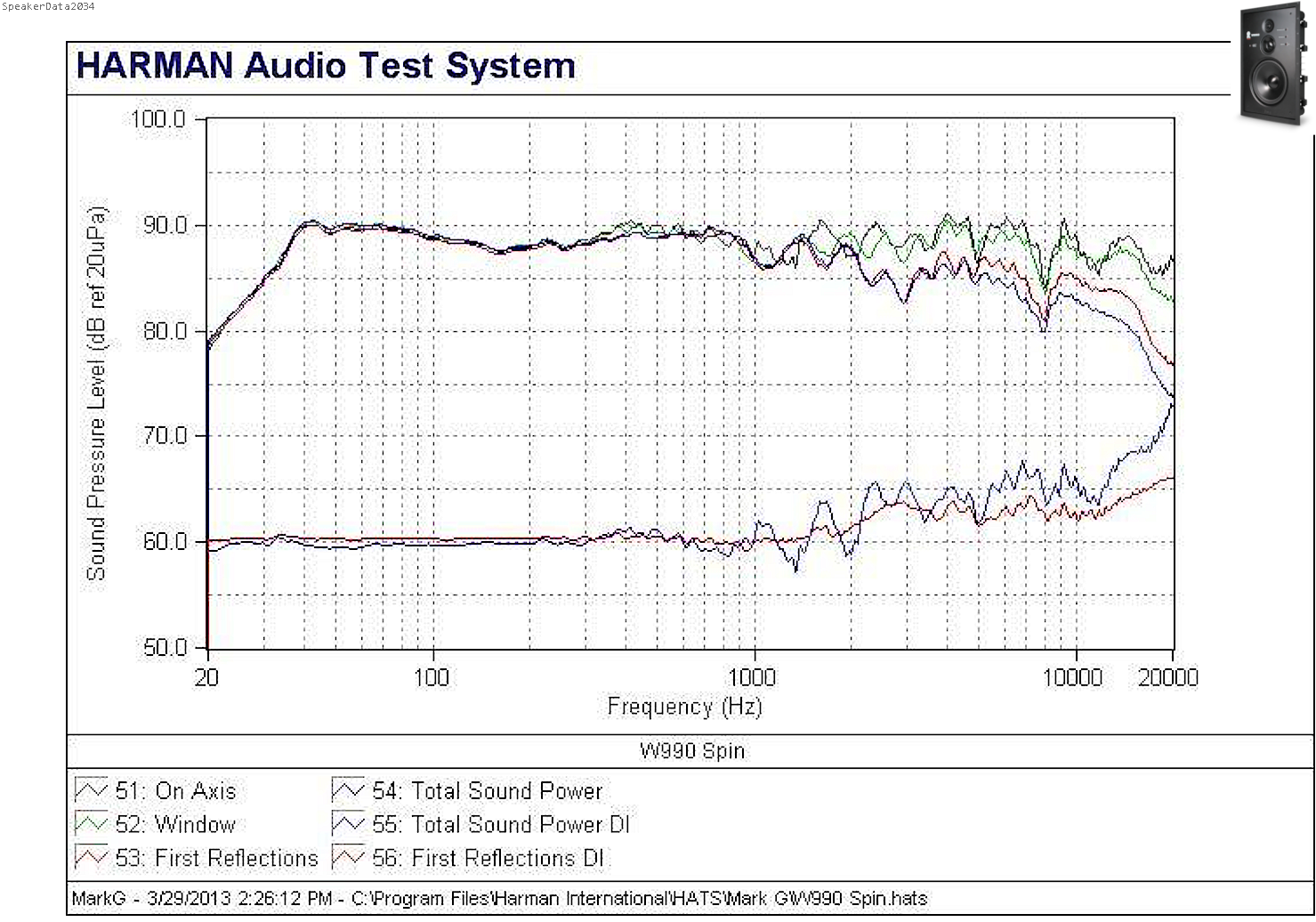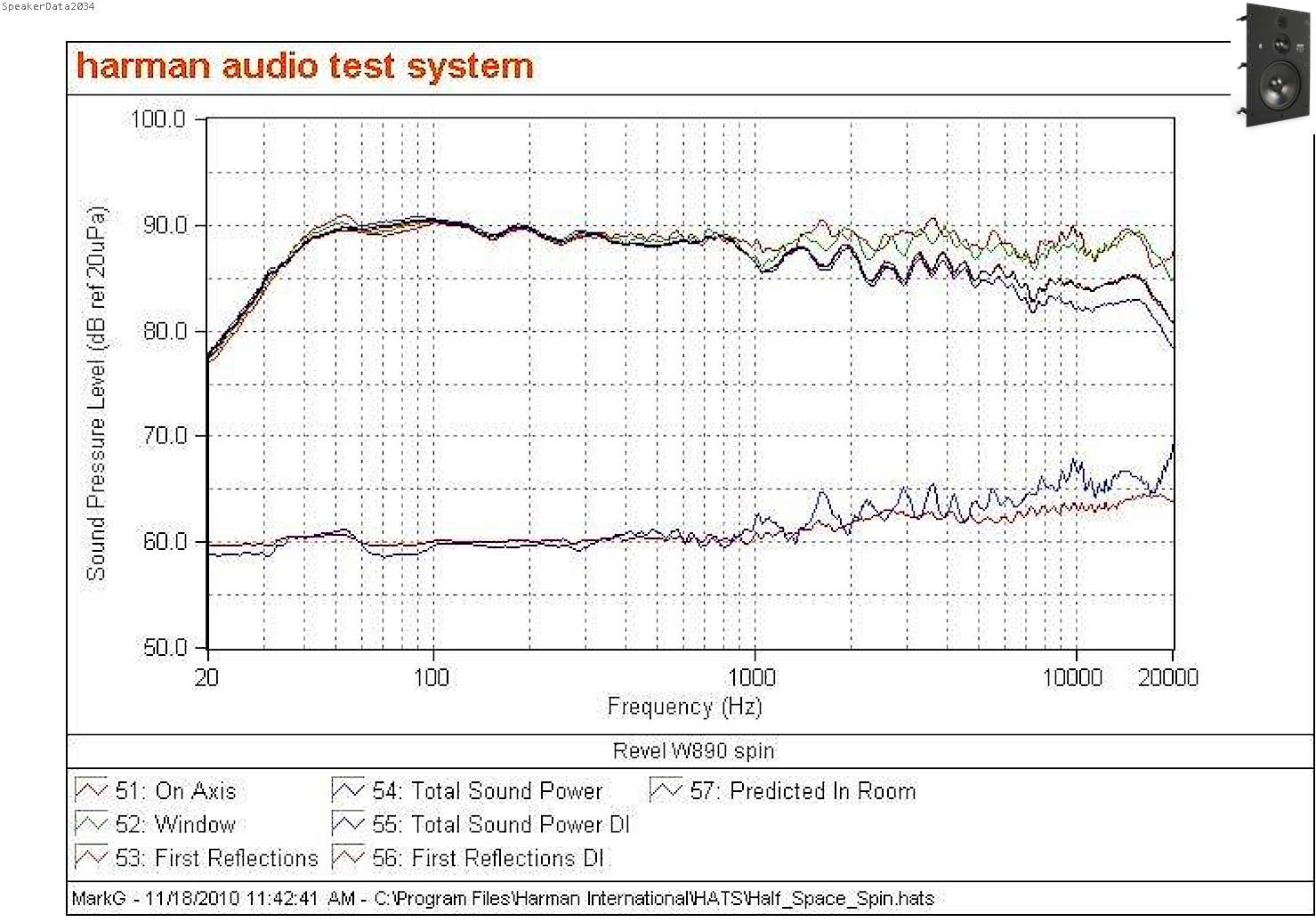This is a review and detailed measurements of the Revel W990 in-wall speaker. It is on kind loan from a member and costs US $1,750 each.
Note: our company Madrona Digital is a dealer with Harman and I suspect we have installed thousands of their in-wall products over the years. While I have no way of shaping the measurements to favor one product or another, feel free to read any bias you like in my subjective words.
As I had feared, I had to build yet another baffle to test the Revel as the last one I built for monoprice was a different size:

I was out of wider panels. Ideally there would be more of a gap above and below the speaker for measurements. Here is a back shot of it:

The mounting studs are quite a bit more beefy than the ones monoprice used. I was surprised that the capacitors were Revel branded. They must have enough volume to justify getting custom caps like this.
EDIT: the measurements you see are using a special method called Klippel NFS Baffle that is designed to get rid of limitations of measuring a speaker mounted like above. It is able to get rid of diffraction caused by the edges of that baffle. Importantly, it also gets rid of both room reflections and sound coming from the back of the speaker. The result is a measurement that represents "infinite baffle" which you sort of get when you mount them in a large wall.
I had to measure the speaker three times. The challenge is that Klippel NFS in this type of measurement only allows one position to be specified which has to be the center of the radius encompassing the whole unit. This point is at the suspension of the woofer and not where the sound field is most complex (tweeter). As a result, the first scan produced mostly garbage above mid frequencies. I upped this on the second scan, not realizing the boundary scan switch was on which screwed up the bass. So a third scan had to be done. Due to reference point not being the tweeter, the response is not reliable above 10 kHz:
So a third scan had to be done. Due to reference point not being the tweeter, the response is not reliable above 10 kHz:

If you look all the way to the right, you can see how the measured and computed responses differ. On the other hand, on the left we see the magic of Klippel NFS not only filtering out diffraction caused by the baffle edges, but also compensates for the back wave coming forward, causing cancellation. The computed bass response takes this into account and as you see, shows the more proper bass which you would get when you mount this speaker on a wall.
Revel W990 Measurements
Remembering the above limitation and the reference being the upper part of the woofer surround, we get this:

This is not the kind of response I expect to see from Revel and at this high price point. I don't know if we have some measurement error or not. Here is Revel's own spin graph:

The dip around 150 Hz is there as well and so is the chewed up response of the tweeter. But the level matching is better there in their measurements than mine.
As noted, I also ran a test with the boundary compensation on (but at lower resolution):

Here are the individual driver responses:

Our early window and predicted in-room response is not designed for in-wall speaker but here they are anyway:


Horizontal beamwidth is broad up to a point but then narrows beyond the surface of the wall:

Ignore the response above 10 kHz per earlier note.
I don't know why but Klippel software decided to switch to ±180 degrees for these two directivity plots:


Some of you asked for this but I think it makes it harder to interpret the plots. Anyway, keep the listening angle within 30 degrees of vertical.
Here is our 3-D directivity plots:

Note that you only get what is to the right of the vertical line as the rest is behind the wall. response is very good at 1000 and 2000 Hz. 3000 Hz may be screwed up due to baffle I built being too short vertically.
There was really good news on distortion front:


Note that these are in-room measurements so the on-axis response shown has the errors I showed earlier. Then again, it does show the correct response for the > 10 kHz.
Finally, here is our impedance and phase:

The low impedance requires a good amplifier.
Conclusions
Measuring speakers this way is challenging. Assuming we trust our measurements, the frequency response plots are not great. I expect far better from Revel. Maybe they know something about how these get used resulting in different tuning. Sadly because I don't have a wall to mount them in, I can't tell you anything about the subjective results either. Given what we have, and the high cost, I would not be buying these.
----------
As always, questions, comments, recommendations, etc. are welcome.
Any donations are much appreciated using: https://www.audiosciencereview.com/forum/index.php?threads/how-to-support-audio-science-review.8150/
Note: our company Madrona Digital is a dealer with Harman and I suspect we have installed thousands of their in-wall products over the years. While I have no way of shaping the measurements to favor one product or another, feel free to read any bias you like in my subjective words.
As I had feared, I had to build yet another baffle to test the Revel as the last one I built for monoprice was a different size:
I was out of wider panels. Ideally there would be more of a gap above and below the speaker for measurements. Here is a back shot of it:
The mounting studs are quite a bit more beefy than the ones monoprice used. I was surprised that the capacitors were Revel branded. They must have enough volume to justify getting custom caps like this.
EDIT: the measurements you see are using a special method called Klippel NFS Baffle that is designed to get rid of limitations of measuring a speaker mounted like above. It is able to get rid of diffraction caused by the edges of that baffle. Importantly, it also gets rid of both room reflections and sound coming from the back of the speaker. The result is a measurement that represents "infinite baffle" which you sort of get when you mount them in a large wall.
I had to measure the speaker three times. The challenge is that Klippel NFS in this type of measurement only allows one position to be specified which has to be the center of the radius encompassing the whole unit. This point is at the suspension of the woofer and not where the sound field is most complex (tweeter). As a result, the first scan produced mostly garbage above mid frequencies. I upped this on the second scan, not realizing the boundary scan switch was on which screwed up the bass.
If you look all the way to the right, you can see how the measured and computed responses differ. On the other hand, on the left we see the magic of Klippel NFS not only filtering out diffraction caused by the baffle edges, but also compensates for the back wave coming forward, causing cancellation. The computed bass response takes this into account and as you see, shows the more proper bass which you would get when you mount this speaker on a wall.
Revel W990 Measurements
Remembering the above limitation and the reference being the upper part of the woofer surround, we get this:
This is not the kind of response I expect to see from Revel and at this high price point. I don't know if we have some measurement error or not. Here is Revel's own spin graph:

The dip around 150 Hz is there as well and so is the chewed up response of the tweeter. But the level matching is better there in their measurements than mine.
As noted, I also ran a test with the boundary compensation on (but at lower resolution):
Here are the individual driver responses:
Our early window and predicted in-room response is not designed for in-wall speaker but here they are anyway:
Horizontal beamwidth is broad up to a point but then narrows beyond the surface of the wall:
Ignore the response above 10 kHz per earlier note.
I don't know why but Klippel software decided to switch to ±180 degrees for these two directivity plots:
Some of you asked for this but I think it makes it harder to interpret the plots. Anyway, keep the listening angle within 30 degrees of vertical.
Here is our 3-D directivity plots:
Note that you only get what is to the right of the vertical line as the rest is behind the wall. response is very good at 1000 and 2000 Hz. 3000 Hz may be screwed up due to baffle I built being too short vertically.
There was really good news on distortion front:
Note that these are in-room measurements so the on-axis response shown has the errors I showed earlier. Then again, it does show the correct response for the > 10 kHz.
Finally, here is our impedance and phase:
The low impedance requires a good amplifier.
Conclusions
Measuring speakers this way is challenging. Assuming we trust our measurements, the frequency response plots are not great. I expect far better from Revel. Maybe they know something about how these get used resulting in different tuning. Sadly because I don't have a wall to mount them in, I can't tell you anything about the subjective results either. Given what we have, and the high cost, I would not be buying these.
----------
As always, questions, comments, recommendations, etc. are welcome.
Any donations are much appreciated using: https://www.audiosciencereview.com/forum/index.php?threads/how-to-support-audio-science-review.8150/
Attachments
Last edited:
